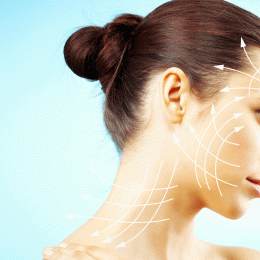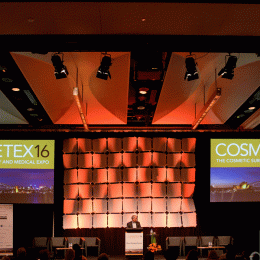They range from angry-looking red stripes to silvery white streaks: stretch marks can make many people feel self-conscious, particularly when the affected areas are exposed to view.
They can occur just about anywhere, but are most common on the stomach, breasts, upper arms, thighs, and buttocks. And many myths abound about them. Catherine Masson, of Phyt’s Organic Skincare, separates fact from fiction:
1) Stretch marks are scars
Stretchmarks are often associated with scars but they are very different. They appear in the skin in an area which has lost its collagen fibres and its elasticity; the skin has become atrophic. On the contrary, a scar could be defined as a reconstruction of the dermis.
2) It is hereditary, so if your mother had them, so will you
The reasons why stretch marks appear are multiple. Genetic factor is often invoked, but other causes are just as common: hormonal (change in contraception method, medical treatments) or physiological (pregnancy, rapid loss of weight, extreme diet).
3) Stretch marks only concern pregnant women
Pregnant women who are expecting are obviously more likely to get stretch marks as their belly rapidly expands to accommodate a growing baby. But these marks are not just a side effect of pregnancy. In fact, they are found to affect, in various degrees, 80 to 90 percent of all women and even 40 percent of men, all age groups and skin type included. They are also very common in teenagers when they grow quickly and have a tendency to gain weight quite rapidly. Another factor impairing the elasticity of their skin at puberty is hormone imbalance.
4) Slim people do not get stretch marks
People who do body building can have stretch marks if they follow an intensive program which results in quick muscles growth.
People who use oral corticosteroid medicines (steroids) can also get stretch marks because these medicines affect the metabolism and increase the appetite, leading to a rapid weight gain.
5) Stretch marks are red when they form, then become white with time
Stretch marks can come in many shapes and sizes: they can be superficial or deep, thin or large. The damage to the elastic fibres of the dermis (the deeper layer of the skin) can start as a reddish or purplish scar-like inflammation, sometimes itchy, before gradually fading to a silvery-white. This is not always the case and they can present a white appearance from the very beginning.
6) Stretch marks become more visible with sun tanning
Tanning in itself has no effect on stretch marks, however it accentuates their visibility. At some point, when stretch marks are forming, the blood circulation beneath them stops working properly which makes those marks take on a white appearance. Once white, they will not react to tanning, and even though you may develop an overall tan, stretch marks will stay whitish and end up being more visible than before. Despite that, it is important to remember that like the rest of your body, stretch marks can still burn and should be protected from the sun.
7) Stretch marks are found in areas that cannot be easily seen
On women, they generally are found on thighs, hips and breast, and on the tummy during/after pregnancy. They can also appear on the lower back, shoulders and calves.
8) Drinking a lot of water will prevent them
It’s important for the health of the body and the elasticity of the skin to drink enough water every day. That being said, drinking large quantities of water is not in itself a preventative measure against stretch marks.
9) Anti-stretch mark creams can prevent them
Anti-stretch mark creams are formulated to stimulate and enhance the intrinsic formation of skin collagen; in that way, they can help. If stretch marks are the consequence of rapid weight loss, the first thing to do is to moderate the weight loss process and avoid the common yo-yo effect. Some cream formulated with vitamin A and prescribed by dermatologists are meant to stimulate skin repair to reduce stretch marks appearance. If the stretch marks are the consequences of pregnancy, massaging the belly with natural plant oil can make the skin more resilient and prevent damage.
10) Laser treatments make them disappear
A laser treatment can improve the appearance of stretch marks but it cannot make them totally disappear. It is easier to treat recent stretch marks and a set of three treatments (one per month) can be recommended. Older marks will require a longer treatment plan, usually over one year. Laser stretch mark removal is highly effective in most cases, but as with any other technique, results vary from one person to the next.
11) Accept to live with them
Stretch marks can be a cause of aesthetic concern and anxiety. For some people, they are such a significant cosmetic concern that they affect their quality of life. Laser therapies, IPL treatments, microdermabrasion and specialised products offer effective treatments for stretch marks. There are also ways to conceal stretch marks with body makeup. If you can, consider and remember they are not life threatening, and that living with them (while doing what you can to camouflage them) may end up more beneficial to your health than constantly stressing about them (we all know the damage caused by ongoing stress).
HOW TO PREVENT STRETCH MARKS
Whatever the reason, stretch marks are the end result of a skin which “breaks”, leaving the skin marked and wrinkled. The best way to prevent them is to maintain or improve the elasticity of the skin:
It’s important that skin maintains its elasticity, so a reasonable intake of water is recommended (teas, broths, fruits – also good to detoxify your system). It provides hydration to the skin from the inside and helps keep it supple.
However, internal hydration is not enough; the surface of the skin must be kept hydrated and nourished with ultra-rich creams, anti-stretch marks products and nourishing and regenerating oils.
Maintain collagen and elastin fibres in good condition by eating food rich in vitamins it E and C, zinc and silica.
Gentle exercise improves circulation which in turn improves skin’s elasticity
Keep an eye on your weight.
IF YOU DO GET STRETCH MARKS
Ways to treat them at home:
With specialised anti-stretch marks products that stimulates the formation of collagen – such as Phyt’s Expert Vergetures with aloe vera gel to heal and soothe the skin, or with nourishing oils such as rosehip prickly pear seed. These two oils are rich in amino acids which stimulate collagen production and promote skin’s elasticity. They work better on new stretch marks than on old ones.
Use them to massage the area with stretch marks: knead the skin to break the collagen fibres and force them to realign themselves.
Follow with a rich moisturiser to nourish and hydrate the skin.
Ways to treat them with aesthetic medicine:
There are several methods to reduce the appearance or eliminate stretch marks.
These techniques have multiple aesthetical actions: they make the skin smoother, brighter and they reduce imperfections, scars and pigmentation.
Medium or deep peeling to remove the upper layer of the skin which eliminates damaged skin cells. It maximises the regeneration of the epidermal or dermal tissue.
Pigmentation lasers are used to destroy pigments that are present in stretch marks.
Fractional lasers can treat very small areas of the skin by causing micro wounds to the area of the stretch marks being treated while preserving surrounding areas to accelerate healing. That way, skin’s repair starts deep in the dermis.
Carboxytherapy (carbon dioxide – CO2 – is infiltrated into the subcutaneous tissue to kill fat cells and increase blood flow) helps improve local tissue metabolism. The treatment results in fewer fat cells and a firmer subcutaneous tissue.




